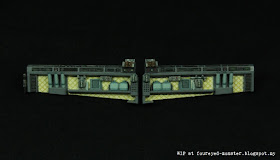From inside to out is how the Snowspeeder is most likely going to be painted. That means starting from the inside the cockpit interior to the pilots, then the canopy together with the main upper/lower hulls, followed by the back engines, laser system, repulsors and ending with a general weathering process. Some decals will be used but it'll generally be a spray-can and hand-brush painting effort.
 |
| Bandai Star Wars 1/48 scale Snowspeeder - work-in-progress on the cockpit interior |
Inspiration for the snowspeeder cockpit interior's colour scheme was twofold. Firstly, a
DK reference book titled
Star Wars: Complete Vehicles. That's when the possibility of an interior with warmer hues first occurred to me. Secondly,
The Empire Strikes Back showed the snowspeeder interior -
what can be seen anyway as its lower sections weren't visible in the film frames - in a cooler colour scheme. That made sense as a form of counterbalance to the pilots warmer colours i.e. skin tones and orange flight suits. In the end, I combined both colour concepts for my own version of the interior.
 |
| Snowspeeder cockpit interior's main colour scheme - a mixture of cool and warm hues |
 |
| Snowspeeder cross-section and interior, source: Star Wars: Complete Vehicles |
One key thing I did was to lighten the cockpit interior's warm hues on the padding-like texture from a dark yellow as seen in the DK reference material to a lighter hue of creamy white (
cremeweiß in German or spelt cremeweiss in English). Then to add a some 'pop' into a generally dull grey/metallic look of the cockpit interior, I used neutral greys in conjunction with greenish and bluish greys. These came in the form of
Vallejo Model Color acrylic paints (
see second photo above).
 |
| Snowspeeder's cockpit interior stretched out in a line sans the seats |
To create extra detail in the snowspeeder cockpit interior, I did the
best I could at this scale to paint some screen displays on both the
pilot and tail gunner's instrumentation panels. This translated into a radar
ping on the gunner's left most display and lines of computer text on the
pilot's main screen.
 |
| Instrumentation panels for the snowspeeder's gunner (left) and pilot (right) |
 |
| Cremeweiss hue on interior's padding was inspired by a DK book titled Star Wars: Complete Vehicles |
That I'm okay with the fact that results aren't anywhere near how I
envisioned them is a testament to my newfound hobby-related trait of
letting go at the right time. So instead of unnecessarily
spending precious time to enhance a paint job, I am slowly learning to
step back and stop when such an effort is pointless (beyond fulfilling
one's obsessive-compulsive tendencies). Once the pilots are glued onto
their seats, most of the cockpit interior will be hidden from view.
Focus will also shift towards the more brightly coloured pilots. Hence
more paint-hours will, alternatively, be spent on the pilots.
 |
| Pilot instrumentation panel - text lines on the display screen up the realism factor |
 |
| Tail gunner instrumentation panel - main details added include the radar ping display and a big red button |
 |
| Pale greyish blue/green hues were balanced by the cremeweiss (creamy white) hue |
 |
| Quick trivia - cremeweiss hue on interior padding could also be found in interiors of German WW2 tanks |
 |
| Seat colours were based on what I could make out in the Empire Strikes Back Hoth battle scenes |
Now if this project was about a grounded snowspeeder under repairs in a
rebel base then it would've been a different story entirely. In such a scenario, focus would be on the cockpit interior. And with it the need for more paint hours to be invested in the said area. But this isn't my intention for this build so what you see here is about as far as I'm willing to go for the cockpit interior.
 |
| Snowspeeder cockpit interior as compared to a paperclip and a five sen coin for scale |
My hopes are on the snowspeeder pilots being the 'wow' factor of the cockpit area. To me, that means painting the pilots in such a way that they are discernible as Wedge Antilles and Wes Janson. At this scale, I'm under no illusions as to how tough this is going to be. More so when I don't have any helmet decals to assist me in creating Wedge and Wes lookalikes. But if my enthusiasm for painting miniature figures again is any indication (especially after weeks of pure vehicle work) then I might just pull it off. Leia's last words to the snowspeeder pilots were
good luck ... I'll need that for sure.











.jpg)




































